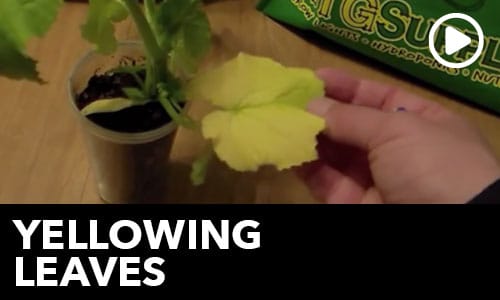Transcription:
Well if you clicked on this video you must have some problems with fungus or think you do. I had a very severe fungal outbreak it was in my greenhouse and it spread around to all areas even to my house and most of my plans were being infested with this fungus and I’m many my seedlings that couldn’t even grow seedlings they kept dying so for a few weeks. I couldn’t grow plants so fungus is something that can affect anybody anywhere and so in this video what I want to do is show you a few pictures of what fungal infections look like and then we’ll talk about ways to get rid of the fungus and ways to prevent fungus from getting in your grow area in the future whenever you notice that your leaves are not a nice dark deep green it’s time that you need to take action. one of the most common discolorations is what you’ll see here where the lower leaves begin to yellow this is not a real problem and it’s certainly not a fungal infection here’s a close-up of the leaf notice the entire leaf is yellowing it’s not individual small little spots when the lower leaves are yellowing it means you’re over watering your plants or that this leaf is not getting enough light or that the plants aren’t getting enough nutrients and the nutrients are being taken from this leaf and moved up to the plant and you don’t need to worry too much about an overall yellow leaf on the bottom of your plant. this is not a fungal infection notice on this leaf that there are little grey spots everywhere this is one of the signs that tells you that you have a fungal infection here we can see the lease a little closer notice that there are several irregular shaped grey spots all over the leaf and they’re not just at the leaf margins or edges this is a good sign that unfortunately you have a fungal infection you certainly don’t need a PhD to diagnose that this plant is having some serious problems. Notice that now there’s not small little grey dots it’s a fungal infection of spread and now entire parts of the leaf are now brown and necrotic meaning they’re dead.
I would remove this plant from the greenhouse there’s really no way that this plant can be saved at this point so what you want to look for for many types of fungal infections. If not these gray spot areas are spots of yellow with brown around them notice the irregular shaped spots here this is a sign of a fungal infection and you need to take action to fix it. on this last picture here notice the gray circle spots on the leaves what happened is as I was watering the plants in my greenhouse little drops of water fell off the watering can and created a great environment for fungus to grow on the leaves, so if you have fungus in your grow room there’s a few things we can do to prevent it or slow it down. number one you got to clean if you have any dead plants or old soil get that out of your grow room any leaves that have the fungus on them cut them off get those out of the grow room then you want to wipe down your grow area with a 10% bleach or a 10% hydrogen peroxide solution to get rid of any fungal spores that are in there the next thing you want to do is change the environment so the fungus can’t grow as well nor do that you need to know the temperature and humidity a grow area all the growers for keeping track of temperature humidity. if your humidity is 60% or higher you need to lower that you’re going have to venture grow area also if you don’t have a fan in there increase air circulation is going to make it harder for that fungus to grow so lower the humidity increase the airflow the other thing you can do is introduce beneficial microorganisms into the environment there’s lots of products today that have beneficial organisms in them my favorite of course is stump tea. By introducing these bacteria or the beneficial fungus called micro raisa they’re going to compete with the bad fungus and make it harder for that fungus to grow. next thing you want to do is you want to improve your plants immune system so the plant can fight the fungus itself a couple ways you can do that potassium is shown to improve plants immunity so if you have a fertilizer it doesn’t have a lot of potassium in it look for another fertilizer that does. You want to have high amounts of potassium again don’t overdo it follow directions but make sure your fertilizer has a lot of potassium. That’s the third number now silicon has also been shown to improve plants immunity I use the product called OS a 28 this has silicon in it now this is expensive but you only use a very small amount it is very effective.
So this little bottle will go a long way to boost your plants immunity by giving them potassium and silicon last option is to use a fungicide this is what’s actually going to kill the fungus now the one that I used in like a lot is called SNS 244 this is actually a timeline if you follow the directions it says to spray the plants when they’re not under bright light so I did it right before the night cycle spray the tops and then of course make sure you spray the bottom of the leaves as well because the fungus could be on the top or the bottom another fungicide is called Eagle 20w. Now this is a systemic fungicide so you’re going to water your plants with this and it’s going to be absorbed by the plants and every cell in the plant will have this in it. it says in the directions here not to use this within a month of eating certain plants and I’ve talked to some growers they won’t use this at all because it’s in the plant you don’t know if it’s still in there even after a month but if you’re growing plants like orchids or things you’re not going to consume you might want to start off using a systemic fungicide this really does the trick but it’s usually not recommended these things for plants you’re going to consume. if you finished your growth cycle and you’re still concerned about fungus in the area maybe you’ve had some problems with fungus and your seedlings few things to do with seedlings is you want to germinate them in a soilless mixture a lot of times the fungal spores are in the soil you could try using a starter plug these are sterile when you get them and of course vermiculite is sterile as well so if you’re having problems with the fungus in your seedlings try germinating your seedlings in the starter plugs or vermiculite so that that fungus that might be in the soil can’t get on your seedlings so increase airflow decrease humidity introduce beneficial microorganisms you use the fungicide if you need to and of course start your seedlings with a soilless mix. if you have problems with fungus and your soil I hope this helps if you have any questions please send me an email at [email protected] Good Growing



